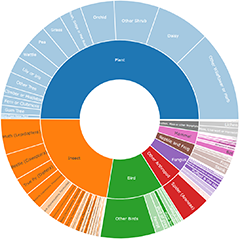Jewel beetles (Buprestidae)
References for Jewel Beetles (family Buprestidae): https://sites.google.com/site/buprestidpages/
And a photo gallery for the family: https://sites.google.com/site/buprestidpages/buprestidae-gallery
This gallery can be searched by genus, for example, Castiarina:
https://sites.google.com/site/buprestidpages/castiarina-gallery
Another good gallery for Castiarina: http://www.virtual-beetle.com/castiarinafp.html
Announcements
There are currently no announcements.
Discussion
MichaelBedingfield
wrote:
5 hrs ago
Hi Allen. It is not possible for me to find other specimens. These photos were taken a year ago at a site that is distant from home.
Buprestidae sp. (family)
entom2
wrote:
Yesterday
Hi Michael, hi Mark, I propose Melobasis sp., possibly Melobasis thoracicus due to the purplish colour. I propose it is at least in Melobasis, not being Ethonion as there is no deep sulcus (groove) whatsoever on the frons between the eyes (a deep sulcus on the frons is diagnostic for all species in Ethonion, a function of the bulbous shape of the eyes), and, though difficult to tell, not Diphucrania as there is no obvious carina on the pronotum laterally, such being present in Diphucrania, nor a shallow sulcus or depressed area between the eyes which is present in Diphucrania. In fact this specimen has no depressed area between the eyes at all. Also, the broad frons (space between the eyes at the front of the head) and which appears to be without a depression and is either flattened or even slightly convex also suggests Melobasis. Happy to be corrected of course. Try to find other specimens, and if you find any try to take some pics looking straight above the specimen if you can. Cheers! Allen M. Sundholm.
Buprestidae sp. (family)
MarkH
wrote:
Yesterday
It’s definitely a Buprestid and , being on Dillwynia, is likely to be either a Melobasis, Diphucrania or Ethonion. I would lean towards a Diphucrania at this stage however without better pictures it may have to remain a mystery
Buprestidae sp. (family)
entom2
wrote:
1 Oct 2025
Given the disparity of specimens which are patently different species attributed in iNat etc to this species, the disjunct distributions of their known populations (which may be a function of localised collecting effort), and importantly the lack of a comprehensive modern revision (requiring careful comparison with types), I would not be surprised if maculate-patterned species such as this prove to comprise several species. Let's hope that some competent person (or persons) will engage in the long-overdue revision of this interesting genus sooner than later. Cheers, Allen M. Sundholm.
Ethonion reichei
Significant sightings
- Temognatha thoracica at Cook, ACT
- Temognatha rufocyanea at Borough, NSW
- Castiarina praetermissa at Brindabella, ACT
- Castiarina xystra at Deakin, ACT
- Neobuprestis frenchi at Kosciuszko National Park
- Cyrioides imperialis at Namadgi National Park
- Castiarina costata at QPRC LGA
- Temognatha affinis at QPRC LGA
- Castiarina erasma at Nimmo, NSW
- Selagis aurifera at Googong, NSW
Top contributors
- Harrisi 1K
- Miranda 71
- AlisonMilton 69
- clarehoneydove 65
- CathB 61
- LisaH 53
- HelenCross 50
- owenh 48
- jb2602 36
- DPRees125 34
Top moderators
- Harrisi 841
- MarkH 266
- MichaelMulvaney 258
- AlisonMilton 211
- entom2 111
- KimPullen 99
- MichaelBedingfield 96
- KimberiRP 88
- Amata 39
- RogerF 11















